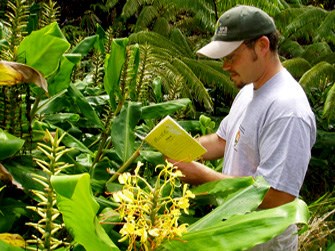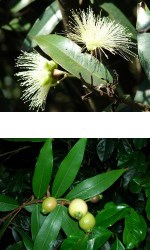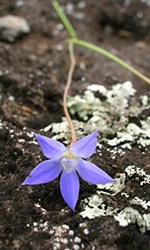Last updated: July 25, 2024
Article
Early Detection Pilot Studies

Pilot studies help refine monitoring methods in the costly struggle against invasive plant species
Aggressive, non-native plants–or invasive species as you may commonly hear them called–are one of the biggest threats to the spectacular endemic plant communities in Pacific island national parks. While Hawai‘i Volcanoes National Park (HAVO), Haleakalā National Park (HALE), and many other National Park Service parks have long recognized the threat invasive plants pose and declared war on them, these battles are costly, time consuming, and sometimes plant invasions pass the point of no return.
The Pacific Island Inventory & Monitoring Network (PACN I&M) has been active in HAVO, HALE, and other Pacific island parks documenting the presence of non-native and native plant species on vegetation maps and within focal plant communities through long-term plot monitoring. While these data provide park managers valuable information on non-native plant species over time, they do not include targeted surveys of critical invasion corridors (e.g., roads, trails, fence lines) where new non-native plants are most likely to establish. Because detecting and eliminating potential invasive species before they become widely established is the most cost effective, and sometimes the only opportunity to eradicate these invaders, the I&M Program is developing an early detection monitoring protocol. Early detection allows resource managers to aggressively target newly established plants and stop the invasion before it starts.
In the summer and fall of 2014, I&M initiated three early detection pilot studies at HAVO and HALE. The objectives of these studies were: (1) to provide the parks immediate data on new species encountered; (2) test the proposed monitoring methods for systematically searching for, finding, and reporting new non-native plant species; and (3) develop time and cost estimates on small scales before implementing these methods network-wide. HAVO requested a study in the summit area of the park as this is where the greatest visitor impacts are felt. Simultaneously, I&M initiated a pilot study at HALE along trails to compliment ongoing park funded road surveys. Finally, the largest pilot study was conducted at HAVO within the Kahuku Unit.
Kahuku was acquired by HAVO in 2003, and while initial biological inventories were conducted, Kahuku is less well studied than older sections of the park. The agricultural history and range of diverse climates and habitats makes Kahuku a prime target for the introduction and colonization of invasive plants. Kahuku contains almost 130 miles of roads and trails... far too many for a two person crew to survey in the time allotted for the pilot study. As a result, the busiest roads and trails were given the highest priority. The crew walked these roads and trails, and anytime an unknown plant was encountered, a GPS point and photos were taken. A sample was also collected when necessary. Once these unknown species were identified, they were compared to lists of species currently known to exist in the Kahuku Unit, the rest of HAVO, and Hawai‘i Island in general. This way the crew could ascertain whether the species in question was just unfamiliar to the surveyors, or was actually a newly established non-native plant species.
Surveying for about one month, crews covered over 76 miles of roads and trails in Kahuku. Depending on what was found and road/trail conditions, crews were able to survey up to 6 miles/day, and cover nearly all the high traffic areas. So what did they find…a lot!
In total, survey crews found 30 unreported species in areas of Kahuku: 11 species new to Kahuku, 3 species new to HAVO, and 1 species new to the Big Island! The species new to the Big Island is the grass, Dicanthium annulatum and will be added to the HAVO species database along with the three other species new to the park. In general, most of the encountered species were grasses and herbs that often produce large amounts of small seeds which are easily spread. In addition, the highest densities of new species found generally corresponded to the roads and trails with the highest rates of use, which is not surprising.

Kim Starr
Threat Found at Hawai‘i Volcanoes National Park
As part of the pilot study, I&M botanists surveyed approximately 19 miles of highly trafficked trails around the Kīlauea summit. These included paths and parking lots stretching from Jagger museum to Kīlauea Iki. In terms of non-native species, the residential area by Volcano House proved to be the most interesting. Surveyors documented several planted ornamentals, including this Syzygium species. After reporting this plant to HAVO, we learned that park management is planning to eradicate this individual since it belongs to the highly invasive family, Myrtaceae. – M. Simon, NPS Biotech (I&M)

Kim Starr
Threat Found at Haleakalā National Park
Over 12 days between the months of September and November 2014, I&M biologists Elizabeth Urbanski and Michelle Osgood conducted a pilot study of the Early Detection protocol at Haleakalā National Park. Approximately 40 miles of trails were surveyed throughout the summit district of the park. The survey resulted in the observation of 3 plant species in 4 locations that were determined to fit early detection criteria at Haleakalā National Park. Strawberry guava, one of the park’s most prolific invaders was found in a new location along the Kaupō trail. A plant never previously recorded in the park called Wahlenbergia gracilis, was found off trail in the front country. – E. Urbanski, NPS Biotech (I&M)
So what’s next? HAVO staff are taking a good look at the list of new species found during the pilot study surveys, and will attempt to identify if any of these species pose a risk of becoming invasive. Any species identified as high risk will be targeted for eradication. Meanwhile, I&M is evaluating the effectiveness of this study to enhance the Early Detection of Invasive Plants protocol and the feasibility of instituting early detection at a larger scale throughout HAVO and other the Pacific island national parks.
– M. Wasser (NPS Botanist, HAVO), and A. Ainsworth (NPS Botanist, I&M), 2015
For More Information
Pacific Island Inventory & Monitoring Network
Inventory & Monitoring at Haleakalā National Park
Inventory & Monitoring at Hawai‘i Volcanoes National Park
Download PDF from the Data Store
